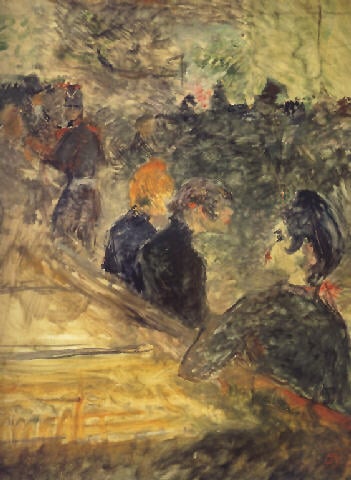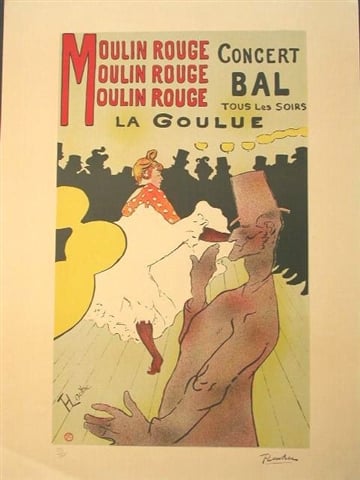Galleries
The Production of Popular Culture: The Work of Henri Toulouse-Lautrec
A look at the social and political meanings in the work of Henri de Toulouse-Lautrec.

A look at the social and political meanings in the work of Henri de Toulouse-Lautrec.

Hillary Chapman

When examining the nature of contemporary culture, it becomes evident that much of the current global structure has its roots in late 19th-century France, where the ideas of marketability and mass culture began to take shape in the way that we understand them today. The concept of advertising, and the strategy of associating products with imagery as a way of appealing to a mass audience, provided the basis for the growth of consumer culture throughout the past century. In late 19th-century Paris, the inherent complications of this new trend were evidenced in much of the work produced by the avant-garde artists of the era, particularly in the district of Montmartre. Alternating between the extremes of revulsion and pleasure, artists such as Henri de Toulouse-Lautrec (French, 1864–1901) and his Impressionist predecessors attempted to portray the contradictions of their age, creating works that delve far deeper into the issues of the day than their fanciful exteriors suggest.
Due to the rapid industrialization of Europe, many cities, including Paris, experienced exponential increases in their population in the latter half of the 19th century. This led to a corresponding growth of the working-class, which in turn played a significant role in the artistic and cultural changes occurring at that time. Prior to industrialization, the conventional artistic values in Europe tended toward the creation of art for an aristocratic audience, and as such, much of the art being produced was inaccessible to a majority of the lower class in both an economic and pragmatic sense. However, the growth of the working class necessitated a new form of creative popular expression. This need was soon met by the expansion of “working-class” entertainment, an industry centered in Montmartre. It was this definitive shift that characterized the work of Toulouse-Lautrec, whose art spoke to a new kind of spectator and, in terms of his choice of subject matter and medium, linked him to the “debased” entertainment of the working class.
In the painting Au bal du Moulin de la Galette, Lautrec depicted the interior of the well-known dance hall, a scene popularized by Impressionist artist Pierre-Auguste Renoir (French, 1841–1919) in his similarly titled work, AuMoulin de la Galette. Set in an outdoor dance hall in Montmartre, and the site of the Paris Commune in 1871, Renoir’s painting would have sent a strong political message to the Monarchist-dominated government of the time. The painting illustrates a collision of social classes: in the lower right corner of the frame, three middle-class bohemian men can be seen drinking and conversing with two lower-class women. Perhaps not shocking by today’s standards, this would have been particularly radical in Renoir’s time considering that the Monarchists tended to associate the Paris Commune with alcohol and the working class.1

Henri de Toulouse-Lautrec, Au bal du Moulin de la Galette, 1889, oil on panel, sold at Christie’s New York

Pierre-Auguste Renoir, Au Moulin de la Galette, 1876, oil on canvas, sold at Sotheby’s New York
Lautrec incorporated similar themes into many of his posters, illustrations, and paintings as he began to explore this type of entertainment in Montmartre in the 1880s. His posters, which were widely circulated throughout Paris at the time, often featured dancers or singers, and were comprised of large, flat blocks of color and thick black lines. His figures are frequently isolated, pushed into the foreground in a manner reminiscent of Japanese prints. Despite unusual and distinct viewpoints, Lautrec maintained a naturalistic perspective, using both space and volume to create compositional harmony.
When the Moulin Rouge opened in 1889, Lautrec produced a number of publicity posters for some of its principle dancers, such as the lithographLa Goulue au Moulin Rouge, which demonstrates his use of pictorial space, as well as his celebration of the erotic. However, when studied closely, the movements of La Goulue as she kicks up her leg to knock the hat off of her partner, appear mechanized, a routine enacted for the benefit of her largely bourgeois audience. By giving this activity an automized appearance, Lautrec exposed the world of Montmartre as one standardized for and catered to the spectator. Through the incorporation of popular forms, he made his own artificial creation that was not really about dancing or eroticism, but rather about the idea of these things. In a manner that was neither moralizing nor condemning, Lautrec, in his numerous portrayals of these activities, depicted a place in which the bourgeois could experience a world completely removed from their own, entirely free of social conventions.

Henri de Toulouse-Lautrec, La Goulue au Moulin Rouge, color lithograph, sold at Gilden’s Arts
Au bal du Moulin de la Galette is a painting very much a part of this milieu, and is also in many ways a commentary on the artificiality of its existence. Unlike his posters, which glorify the exciting, highly sexualized activities that occur within the dance hall, the figures in this painting seem static and disconnected, as if removed from the spectacle around them. It is only after the viewer is greeted by a rather lackluster view of the dancers and patrons that they are able to enter this space, which quickly dissolves into a wash of black, indiscernible forms. It is a juxtaposition of extreme contrasts, expressing the boredom, licentiousness, and listlessness of the “slumming” bourgeois.
Lautrec’s careful choice of media and subject matter can be understood as an assault on the very ideals likely held by the people who found his work, and the culture it reflected, so appealing. Through his extensive use of posters and lithography, as well as his portrayals of lower-class scenes on impermanent surfaces such as cardboard, Lautrec effectively subverts nearly every established convention associated with painting.
When he did paint on canvas, he primed it in a brown hue so it would mimic the appearance of cardboard, thus giving it an air of disposability.2
Lautrec also preferred to mix his paint with turpentine, which gave his figures the thin, flat appearance so often seen in his work. This action was both a literal and figurative means of diluting the work’s value. Through these practices, Lautrec dispensed with the traditional artistic hierarchy, allowing his work to be reflective of popular culture, as well as accessible to it; broadening the concept of spectatorship by bringing it outside the confines of the Salon.
Au bal du Moulin de la Galette presented an alternative to the scenes depicted in both Lautrec’s lithographs and Renoir’s Au Moulin de la Galette. The figures are seen, not as dancers or spectators, at least not to the degree that they are in many of his other works, but as distinct and uncommunicative individuals within the space that had come to symbolize the growth of consumer capitalism and the joys of excess. With the proliferation of advertising and commercialized culture, the events portrayed by many avant-garde artists in the late 19th century inevitably began to lose their original significance. Lautrec illustrated the inherent irony of the modern world: that the development of a mass culture and its efforts toward conformity could ultimately lead to a profound estrangement of both the spectator and the spectacle. In the exploration of this new aspect of modernity, Lautrec demonstrated the contradictions inherent in such a world, visualizing both its vulgarity and its wonder.
1 Howard G. Lay (lecture, University of Michigan, Ann Arbor, MI, November 17, 2009).
2 Reinhold Heller, “Rediscovering Henri de Toulouse-Lautrec’s “At the Moulin Rouge”,” Art Institute of Chicago Museum Studies 12, no. 2 (1986): 127.